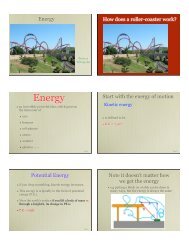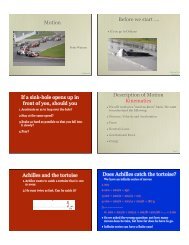Special Relativity
Special Relativity
Special Relativity
You also want an ePaper? Increase the reach of your titles
YUMPU automatically turns print PDFs into web optimized ePapers that Google loves.
Relatively Speaking<br />
Statutory Warning<br />
Peter Watson<br />
Julo<br />
•This lecture is for mature audiences only<br />
•Extreme violence may be caused to your<br />
pre-conceptions<br />
How fast is he moving<br />
relative to the train?<br />
Nandan Sharma<br />
1.Is time travel possible (for human beings)?<br />
2.Why it's a good question: This question has<br />
peaked my curiosity for many years. If we do<br />
develop some sort of H.G. Wells' time machine…<br />
do we create another timeline? Isn't it really the<br />
'present' for us even though we're going 'back into<br />
the past'? Therefore, are we really 'time traveling'<br />
since we are still in the present? Furthermore, to<br />
answer this question, I think that we would need<br />
to explore the basic concepts stated in Einstein's<br />
theory of relativity (time, length relativity, etc.)<br />
The time travel question can also lead us to<br />
explore the idea of worm holes.<br />
•Suppose a train<br />
is travelling at 5<br />
m/s and a bandit<br />
is running<br />
towards the<br />
front at 2 m/s,<br />
relative to the<br />
train.<br />
•How fast is he<br />
moving relative<br />
to the ground?<br />
Relative Motion<br />
How fast is the ground<br />
moving relative to him?<br />
Text
Frames of Reference<br />
The proper name for "point of view" is "frame of<br />
reference": a non-accelerating frame is an "inertial<br />
frame"<br />
• This is Galilean <strong>Relativity</strong>: All inertial frames are<br />
equivalent<br />
• Suppose we do experiment in two different frames:<br />
1.Earth Frame: if we measure a distance(velocity) in<br />
this frame, we will call it x(v)<br />
2.Train Frame: if we measure a distance(velocity) in this<br />
frame, we will call it x'(v')<br />
• In the earth frame<br />
• Results of any experiment can be described in any<br />
frame: no frame is preferred.<br />
• Put differently: you cannot do an experiment to decide if<br />
you are moving, since one man's motion is another<br />
man's station!.<br />
• An non-inertial frame<br />
does accelerate<br />
• Stationary objects can<br />
accelerate without<br />
forces<br />
Non-inertial Frames<br />
e.g. just dropping a ball<br />
•In the train frame<br />
• An inertial frame is one<br />
that does not accelerate<br />
• Stationary objects stay<br />
stationary<br />
Inertial Frames<br />
• Can transform the results of an experiment in any one<br />
frame to any other.<br />
•<br />
• Velocity in earth frame = Velocity of train frame + Velocity<br />
in train frame<br />
• v=v0+v’
and can compare them both<br />
• This is what Galileo would say<br />
• And this is what Einstein would say<br />
Means clocks must measure<br />
different times<br />
Nick Toller<br />
1.How is it possible that scientists recording<br />
neutrinos moving faster than the speed of light?<br />
2.Why is this a good question? It deals with some of<br />
the most basic properties of the Universe (particles<br />
being unable to move faster than light) and is<br />
something topical that appears in news media. It<br />
could also lead into a discussion of other popular<br />
science fiction ideas of faster than light travel and<br />
time travel.<br />
3.(4) Completely explaining this would require an<br />
understanding of general relativity.<br />
Text<br />
Have gone through this in (sordid) detail since it is<br />
wrong!<br />
• We have assumed:<br />
1.Laws of Physics are the same in all inertial frames,<br />
2.Time is the same in all frames<br />
• 2.is a hidden assumption, that was never written down.<br />
• The correct statement (Einstein) is<br />
1.Laws of Physics are the same in all inertial frames,<br />
2.The speed of light is the same in all frames<br />
This means that (since speed = distance/time) distance<br />
and/or time must change when we go from one frame<br />
to another.<br />
Suppose we fire a beam of light from the front of a train.<br />
• From the point of<br />
view of the earth<br />
we would expect<br />
• c=v0+c’<br />
• in fact<br />
• c=c’<br />
•Note that this implies that<br />
nothing can go faster than<br />
the speed of light<br />
Oladunni Abiodun<br />
1.Question: Why is faster-than-light travel<br />
seemingly possible?<br />
2.It is a good question because the concept of<br />
teleportation seems to be based on our ability<br />
to move faster than light so if it was possible<br />
it would solve a lot of transportation and<br />
maybe even communication problems.<br />
3.Seems like something that would have a<br />
pretty straightforward but difficult<br />
explanation<br />
PW
Nothing can go faster than<br />
light<br />
FASTER-THAN-LIGHT NEUTRINOS<br />
CAUSED BY LOOSE CABLE?<br />
'FASTER-THAN-LIGHT' NEUTRINO<br />
TEAM LEADERS RESIGN<br />
• In the earth frame,<br />
the light has to<br />
travel further, since<br />
the train has<br />
moved.<br />
We can solve this<br />
•giving<br />
•but in the train frame<br />
•so t’
The Twin Paradox<br />
•How much does this slowing down of<br />
time matter?<br />
• e.g. Suppose you are in an OC Transpo bus (v0<br />
= 10ms -1 ):<br />
• how slow will your watch appear to run compared<br />
to your clock at home?<br />
• T = 1 hour at home<br />
• Corresponds to 1 hour - 1 picosecond on the bus<br />
• Note that this correction term is tiny for all cases<br />
we are familiar with (which is just as well!)<br />
Twin<br />
Paradox<br />
• The star α-Centauri is 4 light-years distant from<br />
earth.<br />
• Fred and Fred' are both 20.<br />
• Fred' leaves for α-Centauri at .9 c.<br />
•How old is Fred when Fred' gets back?<br />
•28.89 yrs<br />
• How old is Fred'?<br />
• 23.87 yrs<br />
• Hafele-Keating<br />
experiment done<br />
in 1980:<br />
• atomic clock<br />
flown round the<br />
world (firstclass!)<br />
and<br />
compared to<br />
time of atomic<br />
clock "at rest".<br />
• Time lost by<br />
moving clocks ~<br />
So can we measure it?<br />
Note there are a lot of other<br />
consequences<br />
•Length contraction (moving objects<br />
appear to be shorter)<br />
•Increase of mass (objects get heavier the<br />
faster they go, so cannot go faster than<br />
light)<br />
•and<br />
•E = mc 2<br />
Your reaction to all this should be:<br />
•"This is really stupid. What<br />
really happens?"<br />
•Answer: In physics you cannot ask<br />
•"What really happens?"<br />
•The best one can do is ask<br />
•"What can I measure?"<br />
•Reality is a dangerous concept<br />
Vladimir: That passed the time<br />
Estragon: It would have passed in any<br />
case.<br />
Vladimir: Yes, but not so quickly.<br />
Beckett: waiting for Godot.
Time as a fourth dimension<br />
The changes to space and time that Einstein found<br />
show that they are aspects of the same thing:<br />
space-time.<br />
• Galileo-Newton Space is 3-D, time is an<br />
independent quantity<br />
• Einstein-Minkowski, Space-time is 4-D, and motion<br />
mixes space and time in different ways<br />
Following constraints must be satisfied by world-lines:<br />
Must be oriented from past to<br />
future: "flow of time".<br />
◦ Static object remains at same<br />
x, but time still moves.<br />
◦ Moving objects have maximum<br />
slope corresponding to speed<br />
of light.<br />
◦ Events occur when worldlines<br />
intersect<br />
"Light Cone" represents possible paths of signals:<br />
• i.e. interaction need<br />
not be direct, but can<br />
send (e.g.) phone<br />
message.<br />
• Shows person A<br />
sending signal at time<br />
t1 which is received by<br />
B at time t2<br />
• Note times are<br />
measured in A's frame<br />
• Einstein's concept of time can be expressed<br />
graphically by "worldlines" in a space-time<br />
diagram.<br />
•Reduced to 1 space<br />
and 1 time<br />
dimension, can<br />
describe<br />
interactions as<br />
events: e.g 2 men<br />
walk into each and<br />
fall over.<br />
• Possible light paths<br />
are represented by<br />
"Light Cone".<br />
• Cannot escape the<br />
light cone (it includes<br />
all possible futures<br />
for you!)<br />
• Can see the violation of<br />
simultaneity:<br />
• e.g. two flashes of light<br />
are seen as<br />
simultaneous by<br />
observer A but not by B<br />
Light Cone<br />
Some world-lines are<br />
more complex: e.g. a<br />
planet with 2 space<br />
dimensions
Statutory Warning: We have represented time<br />
as a 4th dimension: this does not mean it is the<br />
fourth dimension.<br />
• e.g suppose we have an event now<br />
and one in the future at time t and<br />
position x: the distance is not<br />
(in fact we can't even add space and time).<br />
• We must use<br />
s 2 = x 2 − c 2 t 2<br />
• (note the minus sign)<br />
• but even this needs careful interpretation.<br />
However this 4-D picture is useful. We can analyze the time<br />
in any creative work in the same way:<br />
• e.g. Midsummer Nights<br />
Dream.<br />
• Note this is a gross oversimplification:<br />
• e.g the lovers + fairies +<br />
Bottom have very complex<br />
crossing world-lines<br />
• I’ll put a girdle round the<br />
earth in forty minutes<br />
(Puck)<br />
How do they get to earth?<br />
• If they are travelling at 0.9999 c should only go 600 m<br />
• However, lifetime gets extended (clock runs slow!) to .45<br />
ms<br />
• Can travel 135 km in this time<br />
• Most can get to earth’s surface<br />
e.g. Suppose we send a flash of light:<br />
How does time move in the frame of the light?<br />
• It doesn't: there is no time in this<br />
frame.<br />
• Can we describe this in English?<br />
• Imagine you are a photon<br />
•You can’t<br />
How about a novel?<br />
My Life as a Photon<br />
By<br />
Bit Delight<br />
Time Dilation in practice<br />
• Muons (µ) are particles<br />
like heavy electrons<br />
produced by cosmic<br />
rays<br />
• Originate at 50-100 km<br />
• One goes through you<br />
each minute (on<br />
average)!<br />
• Lifetime ~ 2 µs<br />
How do we explain<br />
this from pov of<br />
muon?<br />
• Lifetime stays the<br />
same (2 µs)<br />
•Length from top<br />
of atmosphere to<br />
ground gets contracted<br />
to 22 m


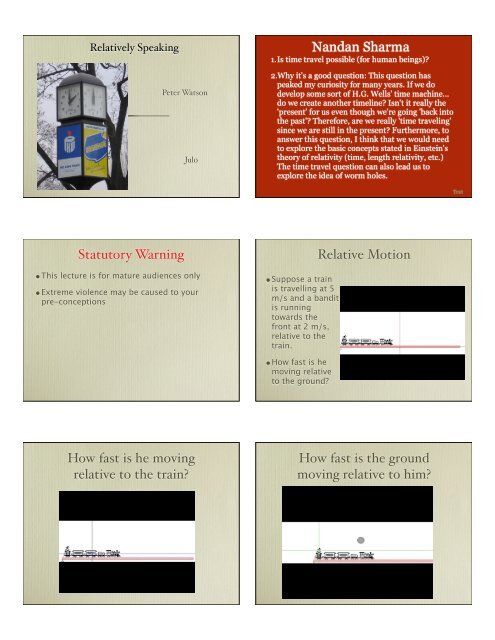


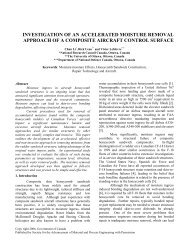
![Assignment 3 [pdf] - Department of Physics - Carleton University](https://img.yumpu.com/19038221/1/190x245/assignment-3-pdf-department-of-physics-carleton-university.jpg?quality=85)
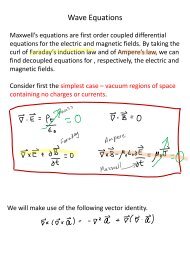
![Assignment 2 [pdf] - Department of Physics - Carleton University](https://img.yumpu.com/19038215/1/190x245/assignment-2-pdf-department-of-physics-carleton-university.jpg?quality=85)

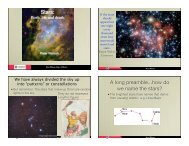
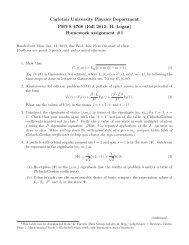
![Assignment 7 [pdf] - Department of Physics - Carleton University](https://img.yumpu.com/19038096/1/190x245/assignment-7-pdf-department-of-physics-carleton-university.jpg?quality=85)
